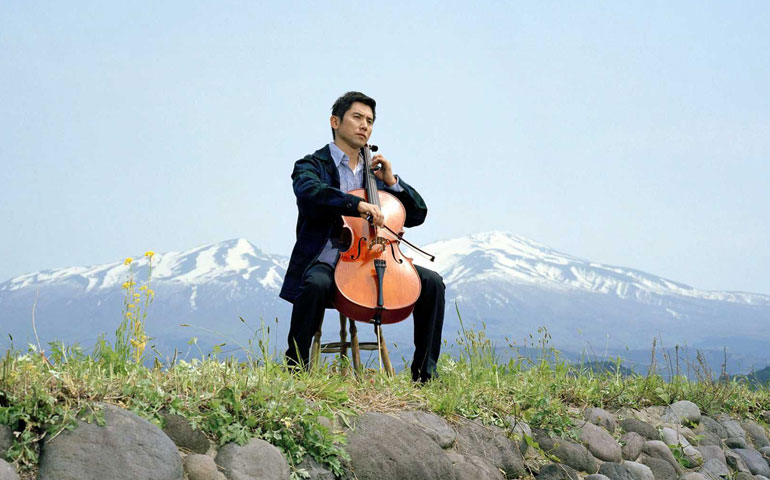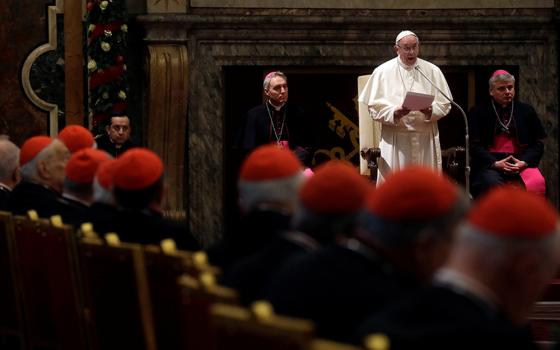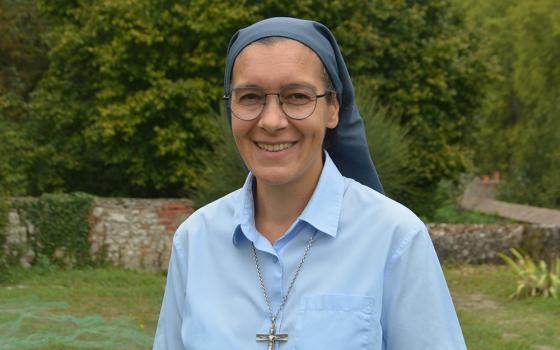
Motoki Masahiro as Kobayashi Daigo in “Departures” (2009 Regent Releasing)
In the Japanese film “Departures” (“Okuribito”), directed by Yojiro Takita, winner of the 2008 Oscar for Best Foreign Language Film, life and death are two expressive movements of one musical piece. Neither is taken as a polar opposite of the other; they dance rhythmically, like the ebb and flow of the ocean tide.
Perhaps it is in the themes of life and death lyrically wedded as a paradoxical “LifeDeath,” that I find renewed inspiration from repeat viewings of the film. “Departures” is a staple screening assignment in one of the graduate courses I teach at the Catholic Theological Union, and spotlighted in a chapter of my latest book The Sacred Foodways of Film. I estimate that I’ve seen it about 30 times in a span of eight years. Each time, I am drawn into a place of profound contemplation and inspiration.
The narrative of “Departures” centers on Kobayashi Daigo (Motoki Masahiro), a professional cellist who loses his job when the Tokyo-based orchestra he plays with folds up. In a pragmatic decision, he and his wife, Mika (Hirosue Ryoko), agree to start life anew in his idyllic hometown of Yamagata, where a modest piece of inherited property, an erstwhile family coffee shop his parents used to run, awaits him.
In a comedy of errors, Daigo takes a newspaper ad for an “NK agent” -- job description alluding to “assisting departures” -- to mean a job opening for a travel agent, only to discover that “NK” is an acronym for nokanfu, a professional “encoffiner” hired to perform a traditional Japanese funeral ritual. The encoffiner elevates the task of cleaning, robing and grooming lifeless bodies into an attentive and graceful art form; his mission is to create a serene and dignified sendoff that is as much a gift for the living as for the dead.
Pressured by the stigma attached to dead bodies, which are viewed as ritually impure in traditional Japanese culture, Daigo keeps his new job as an encoffiner-in-training a big secret, even to Mika, who presumes he is an events planner of sorts.
Daigo’s first assignment proves to be an ordeal, to say the least. Without warning, his boss and sage-like mentor Ikuei Sasaki (Tsutomu Yamazaki) immediately sets him out to work on an extreme case where the body in question is in an advanced state of decomposition. The visceral assault is a rude awakening for Daigo, but as his eyes are opened to the exigency of the encoffinment ritual to the bereaved, he begins to embrace his job as an honorable, quasi-religious vocation.
As Daigo navigates through his newfound calling, his wife and his circle of friends, both having previously ostracized him, gradually overcome their prejudices and come to a place of respect and acceptance for Daigo’s noble work.
A number of scenes serve as virtual front-row-seat invitations to the encoffinment ritual. Coming to close proximity to the stories represented by various grieving families, each different, yet mutually resonant, the cinematic imagery kindles insight: As members of the human family, we are all knitted together by the scarlet thread of our finitude.
Orchestrating these poetic moments is Daigo, once the skittish neophyte who depended on the expertise of his elderly master, now a full-fledged encoffiner. Lead actor Motoki is a marvel to behold; his Daigo is a virtuoso practicing his art with exceptional grace and precision, not unlike Yo-Yo Ma on his cello.
The cello, in fact, plays a key symbolic role in the film. It links Daigo to his estranged father, who encouraged him to play the instrument in his boyhood. A dark cloud blurs Daigo’s memory; he is the proverbial son who has not come to terms with the transgressions of his father who, we learn, ran off with the waitress who worked in their family café. For the sake of NCR readers who have yet to see the film, I refrain from giving spoilers. Suffice it to say that Daigo’s work as an encoffiner will inadvertently offer him one last chance to reconcile with his father.
In my own work, I bring to deeper focus the continuing motif of food in “Departures.” Whether a writhing, live tako (octopus), or fugu shirako (grilled puffer fish roe), I counted 10 food-related references punctuating the running time of the film. Here, food is a scrumptious insistence on life amid the inescapable reality of death; it represents that curious admixture LifeDeath.
I draw attention to a particular sequence, a series of scenes that meaningfully lends integration to the dramatic arc of “Departures.” We see close-up shots of co-workers Daigo, Sasaki and office manager Yuriko (Kimiko Yo) wolfing down mouth-watering pieces of fried chicken. The camera pulls out to reveal that they are gathered in the office, a plastic Christmas tree conspicuously blinking in the background.
When the eating frenzy winds down and Daigo is requested to play something, he uses his boyhood cello, which he found stored in the old house. Sasaki thought it apt that he play something “Christmassy,” which prompts Daigo to ask if there would be any problem with religious affiliation.
The older encoffiner insightfully points out: “Buddhist, Christian, Islam, Hindu, we handle anything.”
With that, Daigo chooses to play “Ave Maria,” an 1853 piece by French Romantic composer Charles Gounod based on Johann Sebastian Bach’s Prelude No. 1 in C Major. The piece -- lyrics based on the “Hail Mary” prayer in Latin -- is a favorite for Masses, weddings and funerals. It’s notable that the Christmas setting and the choice of music bring to remembrance Mary of Nazareth, who intimately witnessed and endured LifeDeath in the paschal mystery of her son.
Just as Daigo’s playing brings Sasaki and Yuriko into a contemplative mood, it seamlessly shifts to the soundtrack of “Departures” and a delicate dance of music and image -- scenes of Daigo performing multireligious encoffinment rites interspersed with painterly images of the natural winter landscape and a flock of feeding cranes -- unfolds.
Like Daigo’s graceful hand strokes as he practices his newfound art, “Departures” eloquently proposes that the thing that gives death a certain poetic beauty is life. And new life.
[Precious Blood Br. Antonio D. Sison is associate professor of systematic theology at Catholic Theological Union, Chicago, and author of the book The Sacred Foodways of Film (Pickwick, 2016).]








